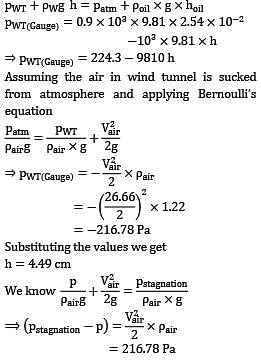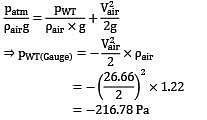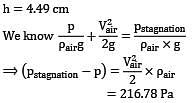Civil Engineering (CE) Exam > Civil Engineering (CE) Questions > Air is drawn into a wind tunnel used for tes...
Start Learning for Free
Air is drawn into a wind tunnel used for testing automobiles as shown in Fig. (ρair = 1.22 kg⁄m3 ; 1 mile = 1.6 km 1 inch = 2.54 cm)
(i) Determine the manometer reading h, when the velocity in the test section is 60 mph. Note that there is a 1-in. column of oil on the water in the manometer.
(ii) Determine the difference between the stagnation pressure on the front of the automobile and the pressure in the test section.

- a)h = 8.6 cm and 347 Pa
- b)h = 9.2 cm and 453 Pa
- c)h = 4.5 cm and 216 Pa
- d)h = 7.2 cm and 502 Pa
Correct answer is option 'C'. Can you explain this answer?
| FREE This question is part of | Download PDF Attempt this Test |
Verified Answer
Air is drawn into a wind tunnel used for testing automobiles as shown...
The manometer will read the pressure of the air in the wind tunnel because of its taping position. So equating pressure at the same level of water (in manometer)


View all questions of this test

Assuming the air in wind tunnel is sucked from atmosphere and applying Bernoull’s equation

Substituting the value we get,

Most Upvoted Answer
Air is drawn into a wind tunnel used for testing automobiles as shown...
The manometer will read the pressure of the air in the wind tunnel because of its taping position. So equating pressure at the same level of water (in manometer)



Assuming the air in wind tunnel is sucked from atmosphere and applying Bernoull’s equation

Substituting the value we get,

Free Test
FREE
| Start Free Test |
Community Answer
Air is drawn into a wind tunnel used for testing automobiles as shown...
The manometer will read the pressure of the air in the wind tunnel because of its taping position. So equating pressure at the same level of water (in manometer)



Assuming the air in wind tunnel is sucked from atmosphere and applying Bernoull’s equation

Substituting the value we get,

Attention Civil Engineering (CE) Students!
To make sure you are not studying endlessly, EduRev has designed Civil Engineering (CE) study material, with Structured Courses, Videos, & Test Series. Plus get personalized analysis, doubt solving and improvement plans to achieve a great score in Civil Engineering (CE).

|
Explore Courses for Civil Engineering (CE) exam
|

|
Similar Civil Engineering (CE) Doubts
Air is drawn into a wind tunnel used for testing automobiles as shown in Fig. (ρair = 1.22 kg⁄m3 ; 1 mile = 1.6 km 1 inch = 2.54 cm)(i) Determine the manometer reading h, when the velocity in the test section is 60 mph. Note that there is a 1-in. column of oil on the water in the manometer.(ii) Determine the difference between the stagnation pressure on the front of the automobile and the pressure in the test section.a) h = 8.6 cm and 347 Pab) h = 9.2 cm and 453 Pac) h = 4.5 cm and 216 Pad) h = 7.2 cm and 502 PaCorrect answer is option 'C'. Can you explain this answer?
Question Description
Air is drawn into a wind tunnel used for testing automobiles as shown in Fig. (ρair = 1.22 kg⁄m3 ; 1 mile = 1.6 km 1 inch = 2.54 cm)(i) Determine the manometer reading h, when the velocity in the test section is 60 mph. Note that there is a 1-in. column of oil on the water in the manometer.(ii) Determine the difference between the stagnation pressure on the front of the automobile and the pressure in the test section.a) h = 8.6 cm and 347 Pab) h = 9.2 cm and 453 Pac) h = 4.5 cm and 216 Pad) h = 7.2 cm and 502 PaCorrect answer is option 'C'. Can you explain this answer? for Civil Engineering (CE) 2024 is part of Civil Engineering (CE) preparation. The Question and answers have been prepared according to the Civil Engineering (CE) exam syllabus. Information about Air is drawn into a wind tunnel used for testing automobiles as shown in Fig. (ρair = 1.22 kg⁄m3 ; 1 mile = 1.6 km 1 inch = 2.54 cm)(i) Determine the manometer reading h, when the velocity in the test section is 60 mph. Note that there is a 1-in. column of oil on the water in the manometer.(ii) Determine the difference between the stagnation pressure on the front of the automobile and the pressure in the test section.a) h = 8.6 cm and 347 Pab) h = 9.2 cm and 453 Pac) h = 4.5 cm and 216 Pad) h = 7.2 cm and 502 PaCorrect answer is option 'C'. Can you explain this answer? covers all topics & solutions for Civil Engineering (CE) 2024 Exam. Find important definitions, questions, meanings, examples, exercises and tests below for Air is drawn into a wind tunnel used for testing automobiles as shown in Fig. (ρair = 1.22 kg⁄m3 ; 1 mile = 1.6 km 1 inch = 2.54 cm)(i) Determine the manometer reading h, when the velocity in the test section is 60 mph. Note that there is a 1-in. column of oil on the water in the manometer.(ii) Determine the difference between the stagnation pressure on the front of the automobile and the pressure in the test section.a) h = 8.6 cm and 347 Pab) h = 9.2 cm and 453 Pac) h = 4.5 cm and 216 Pad) h = 7.2 cm and 502 PaCorrect answer is option 'C'. Can you explain this answer?.
Air is drawn into a wind tunnel used for testing automobiles as shown in Fig. (ρair = 1.22 kg⁄m3 ; 1 mile = 1.6 km 1 inch = 2.54 cm)(i) Determine the manometer reading h, when the velocity in the test section is 60 mph. Note that there is a 1-in. column of oil on the water in the manometer.(ii) Determine the difference between the stagnation pressure on the front of the automobile and the pressure in the test section.a) h = 8.6 cm and 347 Pab) h = 9.2 cm and 453 Pac) h = 4.5 cm and 216 Pad) h = 7.2 cm and 502 PaCorrect answer is option 'C'. Can you explain this answer? for Civil Engineering (CE) 2024 is part of Civil Engineering (CE) preparation. The Question and answers have been prepared according to the Civil Engineering (CE) exam syllabus. Information about Air is drawn into a wind tunnel used for testing automobiles as shown in Fig. (ρair = 1.22 kg⁄m3 ; 1 mile = 1.6 km 1 inch = 2.54 cm)(i) Determine the manometer reading h, when the velocity in the test section is 60 mph. Note that there is a 1-in. column of oil on the water in the manometer.(ii) Determine the difference between the stagnation pressure on the front of the automobile and the pressure in the test section.a) h = 8.6 cm and 347 Pab) h = 9.2 cm and 453 Pac) h = 4.5 cm and 216 Pad) h = 7.2 cm and 502 PaCorrect answer is option 'C'. Can you explain this answer? covers all topics & solutions for Civil Engineering (CE) 2024 Exam. Find important definitions, questions, meanings, examples, exercises and tests below for Air is drawn into a wind tunnel used for testing automobiles as shown in Fig. (ρair = 1.22 kg⁄m3 ; 1 mile = 1.6 km 1 inch = 2.54 cm)(i) Determine the manometer reading h, when the velocity in the test section is 60 mph. Note that there is a 1-in. column of oil on the water in the manometer.(ii) Determine the difference between the stagnation pressure on the front of the automobile and the pressure in the test section.a) h = 8.6 cm and 347 Pab) h = 9.2 cm and 453 Pac) h = 4.5 cm and 216 Pad) h = 7.2 cm and 502 PaCorrect answer is option 'C'. Can you explain this answer?.
Solutions for Air is drawn into a wind tunnel used for testing automobiles as shown in Fig. (ρair = 1.22 kg⁄m3 ; 1 mile = 1.6 km 1 inch = 2.54 cm)(i) Determine the manometer reading h, when the velocity in the test section is 60 mph. Note that there is a 1-in. column of oil on the water in the manometer.(ii) Determine the difference between the stagnation pressure on the front of the automobile and the pressure in the test section.a) h = 8.6 cm and 347 Pab) h = 9.2 cm and 453 Pac) h = 4.5 cm and 216 Pad) h = 7.2 cm and 502 PaCorrect answer is option 'C'. Can you explain this answer? in English & in Hindi are available as part of our courses for Civil Engineering (CE).
Download more important topics, notes, lectures and mock test series for Civil Engineering (CE) Exam by signing up for free.
Here you can find the meaning of Air is drawn into a wind tunnel used for testing automobiles as shown in Fig. (ρair = 1.22 kg⁄m3 ; 1 mile = 1.6 km 1 inch = 2.54 cm)(i) Determine the manometer reading h, when the velocity in the test section is 60 mph. Note that there is a 1-in. column of oil on the water in the manometer.(ii) Determine the difference between the stagnation pressure on the front of the automobile and the pressure in the test section.a) h = 8.6 cm and 347 Pab) h = 9.2 cm and 453 Pac) h = 4.5 cm and 216 Pad) h = 7.2 cm and 502 PaCorrect answer is option 'C'. Can you explain this answer? defined & explained in the simplest way possible. Besides giving the explanation of
Air is drawn into a wind tunnel used for testing automobiles as shown in Fig. (ρair = 1.22 kg⁄m3 ; 1 mile = 1.6 km 1 inch = 2.54 cm)(i) Determine the manometer reading h, when the velocity in the test section is 60 mph. Note that there is a 1-in. column of oil on the water in the manometer.(ii) Determine the difference between the stagnation pressure on the front of the automobile and the pressure in the test section.a) h = 8.6 cm and 347 Pab) h = 9.2 cm and 453 Pac) h = 4.5 cm and 216 Pad) h = 7.2 cm and 502 PaCorrect answer is option 'C'. Can you explain this answer?, a detailed solution for Air is drawn into a wind tunnel used for testing automobiles as shown in Fig. (ρair = 1.22 kg⁄m3 ; 1 mile = 1.6 km 1 inch = 2.54 cm)(i) Determine the manometer reading h, when the velocity in the test section is 60 mph. Note that there is a 1-in. column of oil on the water in the manometer.(ii) Determine the difference between the stagnation pressure on the front of the automobile and the pressure in the test section.a) h = 8.6 cm and 347 Pab) h = 9.2 cm and 453 Pac) h = 4.5 cm and 216 Pad) h = 7.2 cm and 502 PaCorrect answer is option 'C'. Can you explain this answer? has been provided alongside types of Air is drawn into a wind tunnel used for testing automobiles as shown in Fig. (ρair = 1.22 kg⁄m3 ; 1 mile = 1.6 km 1 inch = 2.54 cm)(i) Determine the manometer reading h, when the velocity in the test section is 60 mph. Note that there is a 1-in. column of oil on the water in the manometer.(ii) Determine the difference between the stagnation pressure on the front of the automobile and the pressure in the test section.a) h = 8.6 cm and 347 Pab) h = 9.2 cm and 453 Pac) h = 4.5 cm and 216 Pad) h = 7.2 cm and 502 PaCorrect answer is option 'C'. Can you explain this answer? theory, EduRev gives you an
ample number of questions to practice Air is drawn into a wind tunnel used for testing automobiles as shown in Fig. (ρair = 1.22 kg⁄m3 ; 1 mile = 1.6 km 1 inch = 2.54 cm)(i) Determine the manometer reading h, when the velocity in the test section is 60 mph. Note that there is a 1-in. column of oil on the water in the manometer.(ii) Determine the difference between the stagnation pressure on the front of the automobile and the pressure in the test section.a) h = 8.6 cm and 347 Pab) h = 9.2 cm and 453 Pac) h = 4.5 cm and 216 Pad) h = 7.2 cm and 502 PaCorrect answer is option 'C'. Can you explain this answer? tests, examples and also practice Civil Engineering (CE) tests.

|
Explore Courses for Civil Engineering (CE) exam
|

|
Suggested Free Tests
Signup for Free!
Signup to see your scores go up within 7 days! Learn & Practice with 1000+ FREE Notes, Videos & Tests.
























